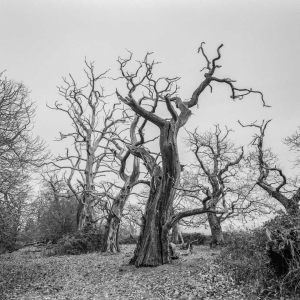Ancient Trees
Photography Gallery
Brampton Bryan, Herefordshire
Photography Gallery
Croft Castle, Herefordshire
Photography of Ancient Trees
Since February 2023 I’ve been photographing trees Brampton Bryan Park and Croft Castle Park (National Trust) in North Herefordshire. In collaboration with landscape artist Richard Gilbert, who introduced me to a these locations that have fine examples of ancient, veteran and notable trees. This led to further collaboration with three painters and three sculptors, including Richard himself, in a small show during Herefordshire Art Week (hArt) in September 2023. I am indebted to him for his encouragement and guidance, as well as his enthusiasm and introduction to these wonderful trees and landscapes.
The story so far…
I’m documenting the trees and the landscape in this beautiful part of the world, using their stunning beauty and mystery to highlight their importance and uniqueness. These trees are important as natural habitats for other flora and fauna, as well as been a precious form of ‘carbon sinks’.
Firstly it took some orientation and discovery, getting to know the trees, the landscape, the light and atmosphere. Although exploring visually, it was also about being aware of the smells, sounds, feel and atmosphere of this ancient parkland. The first visits in February were on cold winter days, with dull grey skies and soft light. Seeing some of these ancient trees made me think about age and ageing, most of them are somewhat older than me, and will most likely outlive me by some margin! Their broad, twisted trunks, bulbous burls (a result of some form of stress such as an injury or a viral or fungal infection), stag-headedness (dead, antler-like branches extending beyond the crown), and bark, bearing the ‘scars’ of age became my photographic subjects.
Early images were made with a digital camera and a number of lenses, and were taken in colour. However, something was amiss. I started converting some of these colour images into monochrome, and noted some improvement in the images as they became more graphic, and, without the influence of colour they took on a different look. Researching other photographers approaches to photographing trees and woodlands, I found great beauty and a more graphic quality in their black and white film work.
Influenced by these experiments and my research, a breakthrough came when I started using black and white film. Initially, 35mm film cameras, then progressing to a medium format film rangefinder camera that I’ve had for the last 25 years. This camera led me to work in a more considered way, slower, and with greater awareness of composition and light. Simplifying my process by using this camera meant creating the image within the square viewfinder and using just one lens with a moderately wide angle of view. These limitations seemed to allow me to concentrate on what was important. To date, I am able to show photographs from two locations that I have spent some time at during 2023. During January 2024 I have started planning and visiting other locations within a 25 miles radius from where I live in Leominster, Herefordshire. This will take me into South Shropshire, East Powys, West Gloucestershire and Monmouthshire.
Locations where I am photographing ancient trees in 2024:
- Brockhampton Estate (National Trust)
- Clay Vallets Wood Nature Reserve (Herefordshire Wildlife Trust)
- Davies Meadows Nature Reserve (Herefordshire Wildlife Trust)
- Monnington-on-Wye (Wye Valley Walk)
- Lingen (Herefordshire)
- Southern parts of Offa’s Dyke (Herefordshire, Powys, Shropshire, Monmouthshire)
- The outlying countryside around Leominster (Herefordshire)
- The Forest of Dean (Gloucestershire)
- Croft Ambrey, Hill Fort (Herefordshire)
‘..those grey old men of Moccas, those grey, gnarled, low-browed, knock-kneed, bowed, bent, huge, strange, long-armed, deformed, hunchbacked misshapen oak men that stand awaiting and watching century after century biding God’s time with both feet in the grave and yet tiring down and seeing out generation after generation.’
The Reverend Francis Kilvert,1876
‘Ancient and veteran trees are a link to our past. They form a large part of our cultural heritage and are extremely valuable for wildlife. One of the first steps in protecting an ancient or veteran tree is to help people understand the value of these trees. It is also vital to record the presence of ancient trees.’
‘Ancient trees are irreplaceable. Steeped in history, these impressive trees have been standing tall for hundreds of years, witnessing momentous historical events while providing invaluable homes for wildlife. The older the tree, the more vital to wildlife it becomes.’
‘In human terms, ancient trees take a long time to develop – a couple of centuries for some species, a millennium or two for others, such as Oak and Yew. Even when they do eventually expire, they can still exist for many years as a standing dead or fallen tree and continue to evoke strong emotions.’
Ray Hawes, National Trust in ‘Britain’s Tree Story’ by Julian Hight 2011 National Trust Books
‘Britain is one of the least forested countries in Northern Europe but boasts the highest number of ancient trees. What we lack in woodland cover is almost made up for by the historical value of these sylvan beasts…..From a human perspective, it is their constant presence within the community, surviving through one generation to the next and carrying events and stories, that elevates trees to a higher place in our psyche.’
Julian Hight in ‘Britain’s Tree Story’ 2011 National Trust Books


